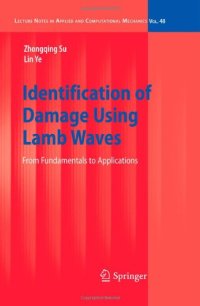
Ebook: Identification of Damage Using Lamb Waves: From Fundamentals to Applications
Author: Zhongqing Su Lin Ye (auth.)
- Tags: Structural Mechanics, Continuum Mechanics and Mechanics of Materials, Automotive Engineering, Structural Materials, Engineering general, Signal Image and Speech Processing
- Series: Lecture Notes in Applied and Computational Mechanics volume 48
- Year: 2009
- Publisher: Springer-Verlag London
- Edition: 1
- Language: English
- pdf
Lecture Notes in Applied and Computational Mechanics
This series aims to report new developments in applied and computational mechanics – quickly, informally and at a high level. This includes the fields of fluid, solid and structural mechanics, dynamics and control, and related disciplines. The applied methods can be of analytical, numerical or computational nature.
Identification of Damage Using Lamb Waves
Since the early 1990s increased interest in the use of Lamb waves (dynamic stress waves travelling in thin plate/shell structures) for identifying damage in engineering structures has led to significant advances in knowledge and technology. Identification of Damage Using Lamb Waves provides essential know-how for developing Lamb-wave-based damage identification techniques. It addresses fundamentals such as the mechanisms of Lamb wave activation, propagation and acquisition, the selection of transducers and design of active sensor networks, and the development of signal processing for de-noising, compression and feature extraction in the time, frequency and joint time-frequency domains. It also provides detailed descriptions of various signal fusion algorithms for the quantitative determination of damage parameters – location, orientation, size and severity. Other key topics include:
• finite element modelling and experimental techniques for Lamb waves;
• active sensor network technology using various agents, e.g., piezoelectric actuator/sensor and fibre Bragg grating sensor;
• software-hardware systems for implementation of Lamb-wave-based damage identification including Lamb wave signal generation, acquisition and processing; and
• representative case studies and diverse engineering applications.
This book provides vital know-how for developing Lamb-wave-based damage identification techniques, addressing fundamentals such as the mechanisms of Lamb wave activation, propagation and acquisition, the selection of transducers and design of active sensor networks, and the development of signal processing for de-noising, compression and feature extraction in different time domains. It provides descriptions of signal fusion algorithms for the quantitative determination of damage parameters. Additional topics include: finite element modelling and experimental techniques for Lamb waves; active sensor network technology using various agents, e.g., piezoelectric actuator/sensor and fibre Bragg grating sensor; identification algorithms based on fusion of extracted signal features; software-hardware systems for implementation of Lamb-wave-based damage identification including Lamb wave signal generation, acquisition and processing; and representative case studies and diverse engineering applications.